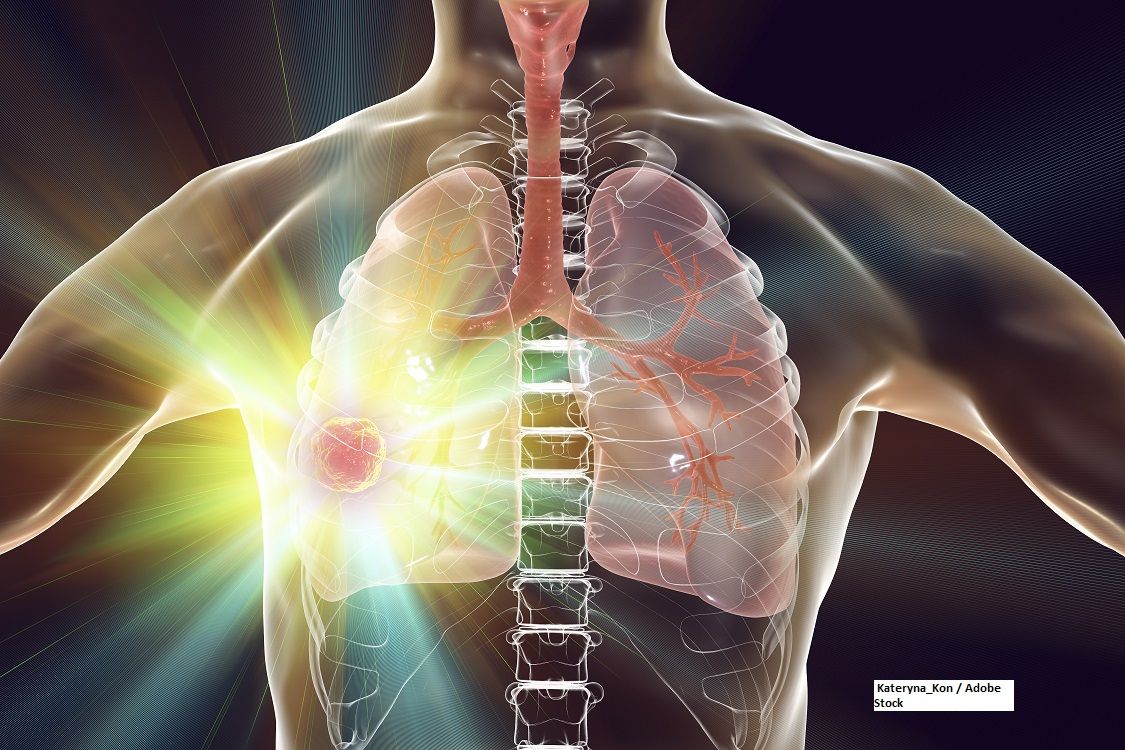Durvalumab Shows Manageable Safety Profile in LS-SCLC
Results showed of the phase 3 ADRIATIC study found that treatment with durvalumab elicited similar radiation pneumonitis incidences vs placebo for LS-SCLC.
Results showed of the phase 3 ADRIATIC study found that treatment with durvalumab elicited similar radiation pneumonitis incidences vs placebo for LS-SCLC.

A manageable safety profile was observed with durvalumab (Imfinzi) consolidation treatment in patients with limited-stage small cell lung cancer (LS-SCLC), with similar radiation pneumonitis incidences occurring compared with placebo, according to findings from the phase 3 ADRIATIC trial (NCT03703297). These data were presented at the 2024 American Society of Radiation Oncology (ASTRO) Annual Meeting.
Safety data showed that any-grade adverse effects (AEs) related to pneumonitis and radiation pneumonitis occurred in 38.2% and 30.2% of patients on durvalumab and placebo, respectively. Grade 3/4 incidence of pneumonitis or radiation pneumonitis was similar between both arms, at 3.1% and 2.6%, respectively, with one grade 5 instance occurring in the durvalumab arm.
Any-grade pneumonitis occurred in 16.4% and 6.4% of patients, respectively; radiation pneumonitis AEs occurred in 23.3% of patients on durvalumab compared with 23.8% on placebo.
“There was an increase in any-grade pneumonitis associated with durvalumab, but when it came down to higher grade toxicity, the numbers were somewhat similar in both arms and actually few in frequency.” said Puneeth Iyengar, MD, PhD, director of the Metastatic Program of the Department of Radiation Oncology at Memorial Sloan Kettering Cancer Center, in a presentation on the data. “What we found was that the patients who were on the durvalumab arm had shorter median time to resolution of symptoms compared to the placebo arm.”
The double-blind, placebo controlled, phase 3 ADRIATIC study enrolled 730 patients with stage I to III LS-SCLC to receive either durvalumab, durvalumab and tremelimumab (Imjudo) or placebo. For the safety analysis, the first 600 patients were randomly assigned 1:1:1 to receive either 1500 mg durvalumab monotherapy every 4 weeks, placebo, or 1500 mg durvalumab every 4 weeks and 75 mg tremelimumab for 4 doses every 4 weeks, followed by 1500 mg durvalumab. Cohorts were stratified by disease stage and whether patients had undergone prior prophylactic cranial irradiation (PCI).
Subsequent patients were randomly assigned 1:1 to either durvalumab monotherapy (n = 264) or placebo (n = 266), both arms of which encompassed the exploratory safety analysis. Treatment continued until disease progression or intolerable toxicity for up to 24 months.
Additionally, patients underwent prior concurrent chemoradiotherapy prior to enrollment in the trial. It consisted of 4 cycles of platinum and etoposide, with RT composed of 60-66 Gy once daily over 6 weeks or 45 Gy twice daily over 3 weeks. Furthermore, RT must have commenced no later than end of cycle 2 of chemotherapy.
Data presented at the 2024 ASTRO Annual Meeting focused on the durvalumab monotherapy and placebo arms. Exploratory safety analyses included incidence of pneumonitis and radiation pneumonitis, and immune-related AEs.
Immune-mediated AE incidences were higher in the durvalumab arm. Among the 2 arms, 32.1% of patients experienced any-grade immune-mediated AEs in the treatment arm vs 10.2% in the control arm. Additionally, grade 3/4 and serious AE occurrence was 5.3% and 9.2% with durvalumab vs 1.5% and 3.0% with placebo, respectively. Immune-mediated AEs leading to treatment discontinuation occurred in 7.3% of the experimental arm and 2.6% of the placebo arm, respectively; 0.4% of patients on durvalumab had an any-grade immune-mediated AE that led to death vs none in the placebo arm.
Common immune-related AEs in both the durvalumab and placebo arms included hypothyroid events (13.7% vs 3.4%), immune-mediate pneumonitis (11.8% vs 3.0%), dermatitis/rash (1.9% vs 0%), hyperthyroid events (1.9% vs 0.4%), adrenal insufficiency (1.1% vs 0%), and hepatic events (both 1.1%).
Further findings showed that prior treatment, such as the prior use of cisplatin or carboplatin, or dosing schedules, did not have an effect on rates of pneumonitis and/or radiation pneumonitis, Iyengar added.
“These safety findings support the favorable risk benefit profile of consolidation durvalumab. This is integrated in the [overall survival] findings of the [phase 3 ADRIATIC] study […] establishing this regimen as a new standard of care for limited-stage small cell lung cancer patients,” Iyengar concluded.
Disclosures: Iyengar cited honoraria from AstraZeneca, Novocure, Johnson and Johnson, and BioConvergent, as well as research funding from Incyte to his institution.
Reference
Iyengar P, Cheng Y, Spigel D, et al. safety profile of durvalumab (D) as consolidation treatment (tx) in limited-stage small-cell lung cancer (LS-SCLC) in ADRIATIC: focus on pneumonitis and immune-mediated adverse events (imAEs). Presented at the 2024 ASTRO Annual Meeting; September 29-October 2, 2024; Washington DC. Abstract LBA13.